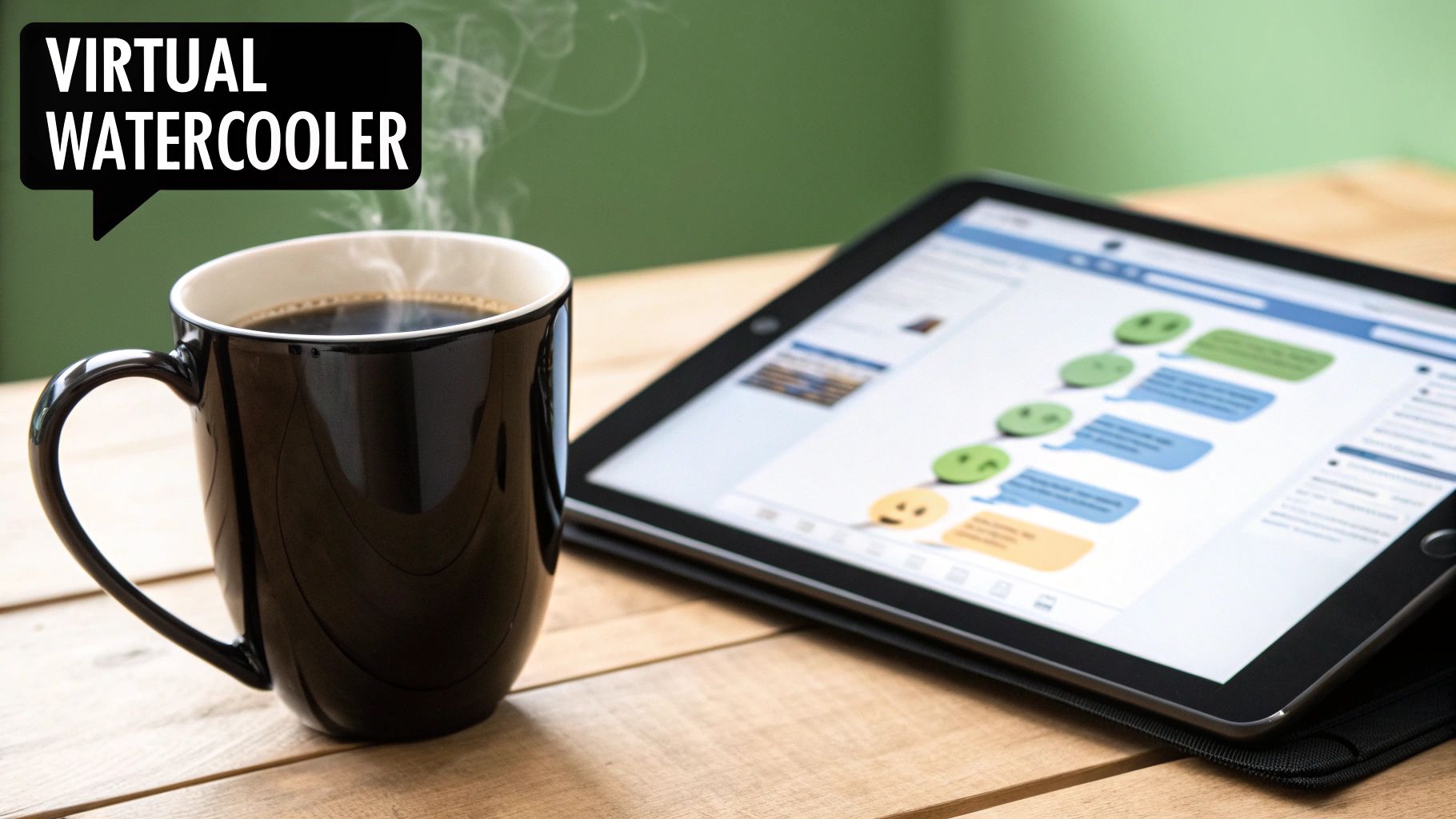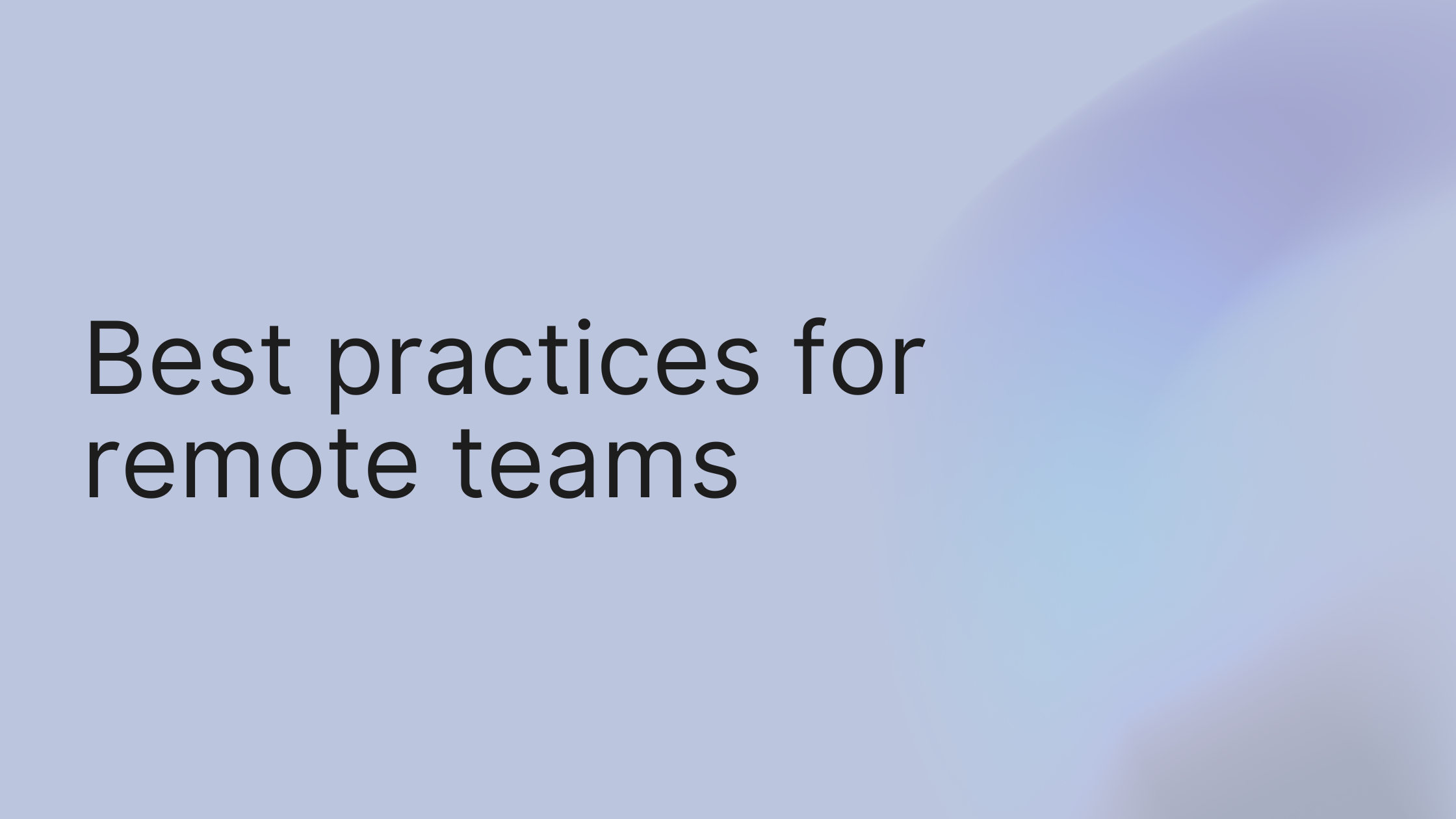Is your team drowning in a sea of Slack messages, endless email threads, and back-to-back video calls, yet important updates still fall through the cracks? This digital chaos is a common pain point for remote teams, leading to missed deadlines and burnout. The quick win: Create a simple "Communication Charter" that defines which tool to use for which purpose. This one document can immediately reduce noise and restore clarity.
This article cuts through the noise to provide a comprehensive roundup of actionable best practices for remote teams. We will move beyond generic advice and dive straight into specific, tactical guidance you can implement today. You'll learn how to establish crystal-clear communication protocols, foster a vibrant and inclusive virtual culture, leverage the right technology stack, and set meaningful goals that keep everyone aligned and motivated. We will cover everything from structuring effective one-on-ones to mastering asynchronous workflows, ensuring your team not only functions but thrives in a distributed environment. For leaders embarking on or refining their remote work strategies, a comprehensive resource like a leader's ultimate guide to managing remote teams can provide invaluable insights to get started.
Instead of just telling you what to do, we’ll show you how to do it with practical examples and step-by-step instructions. Consider this your definitive playbook for building a high-performing, engaged, and successful remote team. Let's get started.
1. Establish Clear Communication Protocols
Do your remote team members constantly ask "Should this be an email, a Slack message, or a meeting?" This channel confusion leads to missed updates and wasted time. The quick win is creating a simple communication charter that outlines exactly where and how your team shares information, eliminating guesswork and boosting efficiency.
This practice is foundational for high-performing remote teams because it replaces assumptions with explicit guidelines. Without it, you risk creating a chaotic environment where urgent messages get lost in casual chat channels and inboxes overflow with non-critical notifications. To foster a cohesive and productive remote environment, consider implementing proven effective team communication strategies that boost collaboration.
How to Implement Communication Protocols
Start by defining the purpose of each tool in your stack. This proactive approach ensures everyone is on the same page, respecting both time zones and focus time. This is one of the most crucial best practices for remote teams to master early on.
Actionable Steps:
- Define Your Channels: Create a document outlining which tool to use for specific communications. For example:
- Slack/Microsoft Teams: For urgent, real-time questions and quick, informal updates.
- Email: For formal announcements, external client communication, and non-urgent messages that require a detailed record. Learn more about optimizing client-facing messages.
- Project Management Tool (e.g., Asana, Trello, growlio): For all task-specific updates, feedback, and progress reports. (UI Call-out: In growlio, you can comment directly on a task or project to keep all related conversations in one place.)
- Set Response Time Expectations: Clearly state expected response times. For instance, instant messages might have a 1-3 hour expectation during work hours, while emails have a 24-hour window. This prevents anxiety and promotes deep work.
- Encourage Status Updates: Guide your team to use status indicators (e.g., "in a meeting," "deep work," "away") and calendar blocking to signal their availability transparently.
Mini Case Study: GitLab's Handbook-First Approach
Pioneering all-remote company GitLab lives by its public handbook, which includes exhaustive communication guidelines. They default to asynchronous communication, meaning conversations happen in public GitLab issues and merge requests, not private DMs. This creates a single source of truth that anyone can access, reducing repetitive questions and making onboarding seamless. This transparent approach is a core reason for their operational success as a globally distributed company.
2. Implement Regular Check-ins and One-on-Ones
Do your remote employees feel disconnected or unsure if their work is making an impact? In an office, quick hallway chats provide informal feedback, but these moments vanish in a remote setup. The quick win is scheduling recurring one-on-ones, creating a dedicated space to maintain connection, address blockers, and ensure personal and professional alignment.
This practice is critical for successful remote teams because it replaces spontaneous, in-person interactions with intentional, structured conversations. Without them, managers risk becoming unaware of brewing frustrations, hidden roadblocks, or declining morale until it’s too late. As famously advocated by pioneers like Andy Grove and Ben Horowitz, these meetings are the single best way to build trust, provide meaningful feedback, and keep your team engaged and moving forward.

How to Implement Regular Check-ins
Start by making these meetings a non-negotiable part of your weekly or bi-weekly schedule. This consistency demonstrates a genuine commitment to your team members' well-being and growth, which is one of the most vital best practices for remote teams. The goal is to create a safe, two-way dialogue, not a one-sided status report.
Actionable Steps:
- Establish a Cadence: Schedule weekly 30-minute or bi-weekly 60-minute one-on-ones. The key is consistency. Also, implement a quick daily or weekly team check-in (e.g., a 15-minute stand-up) to discuss progress and blockers.
- Use a Shared Agenda: Create a collaborative document for each one-on-one where both manager and employee can add topics. This ensures both parties come prepared. Alternate the focus between tactical work progress and broader career development discussions.
- Encourage Two-Way Feedback: Frame the meeting as the employee’s time. Ask open-ended questions like, "What’s one thing we could change about our team to make it better?" or "What support do you need from me this week?". Keep detailed notes to track goals and follow up on previous conversations.
3. Create Virtual Water Cooler Moments
Does your remote team feel more like a collection of disconnected freelancers than a cohesive unit? This lack of personal connection can silently kill morale and creativity. The quick win is to intentionally schedule non-work-related social time, creating "virtual water cooler" moments that replicate the spontaneous bonding of an office.
This practice is critical for remote teams because it directly combats the isolation that can lead to burnout and disengagement. Without these informal touchpoints, relationships remain purely transactional, preventing the trust and psychological safety needed for true collaboration. One of the most important best practices for remote teams is investing in activities that build social capital and strengthen company culture, even across continents.

How to Implement Virtual Social Spaces
Start by dedicating specific channels and times for informal interaction. This signals that the company values social connection and gives employees permission to step away from work tasks to build relationships with their colleagues.
Actionable Steps:
- Dedicate a Social Channel: Create a specific Slack or Teams channel named something like
#water-cooler,#random, or#petsfor non-work chat, memes, and personal updates. - Automate Social Pairings: Use an app like Donut to randomly pair team members for 15-minute virtual coffee chats. This automates introductions and helps people connect with colleagues outside their immediate team.
- Schedule Regular Social Events: Organize optional, low-pressure activities like virtual game nights, online trivia competitions, or even group cooking classes. Be sure to rotate the timing to accommodate different time zones.
- Celebrate Personal Milestones: Publicly acknowledge birthdays, work anniversaries, and personal achievements in your social channel to make team members feel seen and valued.
4. Leverage Asynchronous Work Methods
Does your team's productivity grind to a halt when key members are offline or in different time zones? This reliance on real-time collaboration creates bottlenecks and burnout. The quick win is to adopt an asynchronous-first mindset, designing workflows that allow team members to contribute independently on their own schedules, which drastically increases flexibility and individual focus.
This practice is essential for any distributed team aiming for sustained productivity, as it respects individual chronotypes and global time differences. Without it, you force a rigid 9-to-5 structure onto a model that thrives on freedom, leading to late-night meetings for some and early-morning check-ins for others. Mastering async is one of the most impactful best practices for remote teams, unlocking deeper focus and more thoughtful contributions.

How to Implement Asynchronous Work Methods
Transitioning to an async-first culture starts with a commitment to documentation and intentional communication. Instead of defaulting to a meeting to solve a problem, you default to a documented, shareable format. This shift empowers team members to work autonomously without constant interruptions.
Actionable Steps:
- Document Everything: Create a single source of truth for all processes, decisions, and project plans. When a decision is made, document the "why" behind it in a shared space like Notion or your project management tool.
- Use "Show, Don't Tell" Tools: Replace quick sync calls with recorded videos. Use tools like Loom or Zight (formerly CloudApp) to record screen-share walkthroughs, provide feedback, or explain complex ideas that team members can watch anytime.
- Define Async Response Times: Clarify expectations for non-urgent communication. For example, a request for feedback on a document might have a 48-hour window, giving everyone ample time to provide thoughtful input without derailing their day.
- Decouple Workflows: Design processes where tasks can be handed off without requiring an immediate response. Use task dependencies in your project management tool to automatically notify the next person when a preceding task is complete.
5. Set Clear Goals and Performance Metrics
Are you worried your remote team is busy but not productive? When you can't see people at their desks, it's easy to mistake activity for achievement. The solution is to shift the focus from hours worked to outcomes delivered by setting specific, measurable goals that give everyone clarity and purpose.
This practice is essential for high-performing remote teams because it fosters autonomy and accountability. Without clear targets, team members can drift, priorities can become misaligned, and performance conversations become subjective and difficult. By defining what success looks like, you empower individuals to manage their own time and take ownership of their results. This results-oriented approach is a cornerstone for any organization looking to increase team productivity in a distributed environment.
How to Implement Clear Goals and Performance Metrics
Begin by adopting a proven framework like OKRs (Objectives and Key Results) or SMART goals. Involving the team in the goal-setting process is crucial for buy-in and ensures the metrics are realistic and meaningful. Implementing these best practices for remote teams will create a culture of achievement, not just attendance.
Actionable Steps:
- Adopt a Framework: Choose a goal-setting methodology that fits your company culture.
- OKRs: Use Objectives (ambitious, qualitative goals) and Key Results (measurable, quantitative outcomes) to align the entire company. For example, an Objective might be "Launch a World-Class Customer Onboarding Experience," with Key Results like "Improve user activation rate by 15%" and "Achieve a CSAT score of 95% for new users."
- SMART Goals: Ensure every goal is Specific, Measurable, Achievable, Relevant, and Time-bound. This is great for individual performance and specific projects.
- Make Goals Transparent: Use a shared document, project management tool, or a dedicated platform to make all individual and team goals visible to everyone. This transparency builds accountability and encourages peer support.
- Establish a Review Cadence: Goals are not set-it-and-forget-it. Schedule regular check-ins (weekly or bi-weekly) to discuss progress and conduct more formal reviews quarterly to adjust or set new targets based on business needs.
Pro Tip: When setting remote KPIs, focus on outputs and outcomes, not inputs. Instead of tracking "hours logged," measure metrics like "tasks completed," "customer satisfaction scores," or "features shipped." This reinforces a culture of trust and autonomy.
6. Invest in the Right Technology Stack
Is your team juggling too many apps, leading to subscription overload and context-switching fatigue? This tool sprawl kills productivity and fragments information across disconnected platforms. The quick win is to audit your existing tech stack and consolidate around a core set of integrated tools that truly support your team's workflow, not complicate it.
This practice is essential for effective remote teams because the right technology acts as the digital office, a central hub for collaboration and productivity. Without a well-chosen stack, teams face frustrating bottlenecks, data silos, and communication breakdowns. To effectively support your remote team, it's crucial to equip them with a comprehensive remote work toolkit that streamlines operations.
How to Build Your Technology Stack
Start by mapping your core workflows, from ideation to delivery, and then select tools that support those processes seamlessly. This strategic approach ensures every tool has a clear purpose and contributes directly to team efficiency. This is one of the most impactful best practices for remote teams looking to scale.
Actionable Steps:
- Audit and Consolidate: List every subscription and tool your team currently uses. Identify redundancies (e.g., three different file-sharing services) and eliminate underutilized apps. Focus on a lean, powerful stack.
- Prioritize Integrations: Select tools that work well together. For example, a stack where your project management tool (Asana) integrates with your communication platform (Slack) and your file storage (Google Drive) creates a frictionless workflow.
- Provide Training and Support: Don't just introduce a new tool; invest in proper onboarding and training. Create documentation and offer Q&A sessions to ensure everyone can leverage the technology to its full potential.
- Offer a Technology Stipend: Empower employees to create an optimal home office setup by providing a stipend for essential hardware like ergonomic chairs, high-quality webcams, or a second monitor.
7. Establish Work-Life Balance Boundaries
Is your remote team looking perpetually drained, with late-night messages becoming the norm? This "always-on" culture is a direct path to burnout, turnover, and declining productivity. The quick win is to proactively establish and enforce clear boundaries around work hours, ensuring your team has the space to disconnect and recharge.
This practice is essential for long-term sustainability in a remote setting, where the lines between office and home can easily blur. Without explicit boundaries, you risk creating an environment where employees feel pressured to be constantly available, leading to mental exhaustion and decreased engagement. Mastering work-life separation is one of the most critical best practices for remote teams aiming for both high performance and employee well-being.
How to Implement Work-Life Boundaries
Start by having leadership model healthy behavior. When managers visibly disconnect after hours and take their vacation time, it sends a powerful message that the company values rest and personal time. This creates a culture of mutual respect for everyone's non-work life.
Actionable Steps:
- Set Clear Availability Expectations: Define core collaboration hours when the team is expected to be online for meetings and quick chats. Outside of these hours, explicitly state that responses are not expected until the next business day.
- Encourage Digital Separation: Guide employees to create physical and digital divides. This can mean having a dedicated workspace, turning off work notifications on personal devices after hours, and using separate browser profiles for work and personal use.
- Mandate Time Off: Don't just offer vacation; encourage its use. Some companies even implement minimum vacation requirements or designated company-wide "recharge" days to ensure everyone takes a break. Regularly check in on well-being during one-on-ones to address stress before it becomes burnout.
8. Foster Team Culture and Inclusion
Does your remote team feel more like a collection of disconnected freelancers than a cohesive unit? This sense of isolation can tank morale and collaboration. The quick win is to intentionally design rituals and activities that build personal connections and a shared identity, turning a distributed group into a unified, inclusive team.
This practice is essential for long-term success because culture doesn't just happen by accident in a remote setting; it must be built with purpose. Without intentional effort, you risk creating an environment where team members feel unseen, leading to disengagement and high turnover. Fostering a strong, inclusive culture is one of the most impactful best practices for remote teams, creating the psychological safety needed for innovation and open communication.
How to Implement a Strong Remote Culture
Start by defining your team's core values together and making them a visible part of your daily operations. This proactive approach ensures that every decision, from hiring to project feedback, reinforces the culture you want to build. It's about creating a sense of belonging that transcends physical distance.
Actionable Steps:
- Codify Your Values: Co-create a team charter or culture document that outlines your shared values, communication norms, and mission. Refer to it during onboarding, performance reviews, and team meetings to keep it alive.
- Promote Inclusive Practices: Make simple changes that have a big impact. Rotate meeting times to fairly accommodate all time zones, use inclusive language in all communications, and actively celebrate the diverse cultural holidays and personal milestones of your team members.
- Schedule Non-Work Interactions: Dedicate time for virtual social events. This could be anything from a weekly "virtual coffee" chat, an online game session, or a monthly "lunch and learn" where a team member shares a personal hobby. The goal is to build rapport beyond project tasks.
9. Develop Robust Documentation Practices
Does your team constantly have to ask the same questions about processes, project history, or company policies? This reliance on individual "keepers of knowledge" creates bottlenecks and slows everyone down, especially new hires. The quick win is establishing a centralized, living knowledge base that serves as the single source of truth for your entire organization.
This practice is essential for scaling remote teams because it makes critical information accessible on-demand, across all time zones. Without it, you create knowledge silos where progress halts when a key person is unavailable. Robust documentation democratizes information, empowering team members to find answers independently. This is one of the most impactful best practices for remote teams looking to build a resilient, asynchronous-first culture.
How to Implement Robust Documentation
Start by integrating documentation into your daily workflows, not treating it as an afterthought. This ensures that knowledge is captured as it's created, keeping your resources current and valuable.
Actionable Steps:
- Choose a Central Hub: Select a single tool to house all documentation, like Notion, Confluence, or a simple shared Google Drive folder. Avoid spreading information across multiple platforms.
- Use Templates for Consistency: Create standardized templates for common document types, such as project kick-offs, meeting notes, process guides, and retrospectives. This makes information easier to create and navigate.
- Assign Ownership and Audits: Make documentation a shared responsibility. Assign owners to specific sections of your knowledge base and schedule regular audits (e.g., quarterly) to archive outdated content and update what's changed.
- Integrate with Onboarding: A well-documented company is a dream for new hires. Build your onboarding process around your knowledge base to accelerate ramp-up time. This approach is fundamental to successful client and team integration, as detailed in these client onboarding best practices.
Best Practices Comparison for Remote Teams
| Strategy | Implementation Complexity 🔄 | Resource Requirements ⚡ | Expected Outcomes 📊 | Ideal Use Cases 💡 | Key Advantages ⭐ |
|---|---|---|---|---|---|
| Establish Clear Communication Protocols | Medium – requires ongoing updates | Moderate – communication tools, audits | Improved clarity, reduced miscommunication | Teams with distributed time zones; structured ops | Clear expectations; respectful of time zones |
| Implement Regular Check-ins and One-on-Ones | Medium to High – recurring meetings | High – time investment by managers | Strong relationships, early issue detection | Manager-direct report interactions; personal support | Builds trust; alignment on goals |
| Create Virtual Water Cooler Moments | Low to Medium – set up social spaces | Low – slack channels, apps for socials | Enhanced team culture, reduced isolation | Remote teams needing social connection | Boosts morale; fosters creativity |
| Leverage Asynchronous Work Methods | Medium – process redesign needed | Moderate – documentation tools, async apps | Flexibility, deeper focus, less meeting fatigue | Global teams with time zone differences | Encourages focus; comprehensive documentation |
| Set Clear Goals and Performance Metrics | Medium – planning and tracking | Moderate – goal management software | Increased accountability, outcome focus | Result-driven teams; performance evaluation | Clear direction; autonomy enhancement |
| Invest in the Right Technology Stack | High – selection, deployment, training | High – cost of tools and training | Seamless collaboration; secure workflows | Teams needing robust digital infrastructure | Improves productivity; ensures security |
| Establish Work-Life Balance Boundaries | Medium – policy creation and culture shift | Low to Moderate – training and monitoring | Reduced burnout; improved satisfaction | Teams prone to overwork; wellbeing focus | Sustains employee wellbeing; retention |
| Foster Team Culture and Inclusion | Medium to High – ongoing investment | Moderate – events, training, initiatives | Strong cohesion; diverse and inclusive environment | Distributed teams emphasizing trust & diversity | Boosts collaboration; innovation through diversity |
| Develop Robust Documentation Practices | Medium – initial and continuous work | Moderate – knowledge base tools, maintenance | Transparency; faster onboarding; aligned teams | Organizations depending on knowledge retention | Reduces knowledge silos; supports decision-making |
Final Thoughts
Navigating the transition to a fully remote or hybrid model can feel like assembling a complex machine without a manual. You're juggling time zones, disparate communication styles, and the ever-present challenge of building a cohesive culture through screens. The initial chaos often leads to missed deadlines, team silos, and a creeping sense of disconnection. However, by intentionally implementing a structured framework, you can transform these challenges into your greatest competitive advantages: unparalleled flexibility, access to global talent, and a highly focused, autonomous workforce.
The journey from remote-work chaos to operational excellence is not about finding a single magic bullet. Instead, it's about systematically weaving together a tapestry of proven strategies. This guide has provided a blueprint, covering the critical pillars that support high-performing distributed teams. Mastering these best practices for remote teams is the definitive factor that separates thriving, engaged organizations from those that merely survive.
Recapping Your Roadmap to Remote Success
We've covered a lot of ground, from the foundational importance of communication protocols to the nuanced art of fostering virtual culture. Let's distill these concepts into the most critical takeaways.
Your immediate focus should be on establishing unambiguous communication channels and robust documentation. Without these, every other effort will be built on a shaky foundation. Clearly defining which tool is for which purpose (e.g., Slack for quick queries, Asana for task updates, Notion for permanent documentation) eliminates confusion and empowers asynchronous work, allowing your team to be productive regardless of their time zone.
Secondly, you must proactively cultivate connection and well-being. This isn't a "nice-to-have"; it's a core operational requirement.
- Structured Check-ins: Implement regular, predictable one-on-ones and team syncs to maintain alignment and provide personal support.
- Intentional Culture-Building: Schedule virtual "water cooler" moments, celebrate wins publicly, and create spaces for non-work-related interaction.
- Work-Life Boundaries: Actively encourage and model behaviors like logging off on time, utilizing "do not disturb" statuses, and respecting personal hours. Burnout is the silent killer of remote team productivity.
Finally, success in a remote environment must be measured. Vague expectations lead to anxiety and underperformance. By setting clear goals using frameworks like OKRs (Objectives and Key Results) and investing in a technology stack that provides visibility without micromanagement, you create a culture of accountability and trust. Team members know what they need to do, how their work contributes to the bigger picture, and that they have the right tools to succeed.
Ready to put these best practices into action with a tool built for remote clarity? growlio centralizes your projects, client communication, and team tasks, eliminating the chaos of scattered information. Start your free growlio account today and see how a single source of truth can transform your remote team's workflow.
